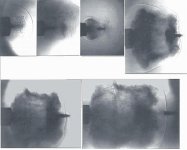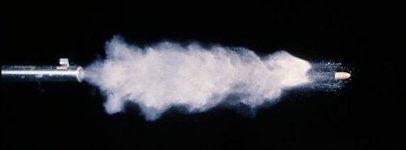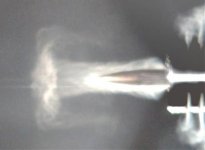C
Charlie Murray
Guest
I have not posted this to try and upset anyone,I am just writing what my expeirence has been.
How this applies to centre fires I have no idea, this is what I have noticed
with rimfires and Air guns.
A few observations,
I have been testing rimfires and there accuracy or lack of it caused by flyers in differing
humidity conditions for over a year now.
In Humidity over 75 % my 17 twist Anschutz will often throw shots, regardless
if you shoot slowly or rapidly.The Highest velocity Eley Match Ammo[chronographed at 1080 fps] hangs in the longest but as you climb to 100% Humidity the flyers are regular and on occasions I have seen elongated holes form in the target.I assume this is from the projectile not being
stabilized.
So next test is with a 16 twist barrel to see if the elongated holes stop
but the flyers continue.
The 16 Twist will shoot up to probably 85-90 % Humidity and then they also
start throwing shots, at 100% humidity the thrown shots get pretty
regular,the holes in the target are still round and not noticeably
elongated.
I have read about water in the barrel thing causing flyers I decided I would sit behind the best shooter at our club to see if different plumes of smoke coming out of the barrel would be any indication in 100% Humidity on which shot would be flyers and if different time lengths between shots also had made any notable difference to these smoke plumes and flyers.
Mick was shooting his rifle [16 twist barrel] and has been on a hot steak this past year and has made the most of the great ammo Eley is making. It really did not make any difference if Mick [who was not told about this test untill he finished shooting]shot slowly or quickly the thrown shots
were still happening and the amount of smoke etc that left the barrel was no indicator to this thrown shot.
[Some shots from the barrel show very little to nearly no smoke at all you
could just see the projectile leave the barrel with a hint of smoke, others shots there was a
very large plume of smoke etc as the projectile left the barrel.]
I assume that the thrown shot because of water in the barrel would be
noticeable as the smoke exiting the barrel would be noticeably more or less
,different colour etc.
Next we went to the club house and shot my FWB 600 single stroke pneumatic
Air gun off a bench in the 10 meter indoor range.These guns at this distance
shoot amazingly small groups time after time so any water in the barrel and innaccuracy
problems would be really noticeable.The other advantage using an air gun is that there is no powder combustion to add to the issue.
Several times now over the last 6 months with this gun and in 100% Humidity
you can get some really impressive plumes of condensation coming out of the
barrel.
Once again you cannot tell which shots are going to land in the bullet hole
size group or step out of it by the water condensation clouds.
I only fired 5 shots last night as I really did not want to risk damaging
the barrel[fingers crossed I have not] and they went into a .05 group which
is pretty normal ,the plumes of condensation although varying greatly from
shot to shot made no difference on target and this has been what I have experienced in the past.
So the water in the barrel thing and its affects on accuracy really intrigues me,Have I missed something obvious and that is why the smoke etc clouds that leave the muzzle or lack of it are not a
good indicater and its relationship to why shots step out?
Also because water is not compressible if a projectile goes over the top of it could we
assume that,
The projectile would be damaged?Causing the inaccuracy for that shot.
The barrel would be damaged?causing permanent inaccuracy
Gas passing the damaged parts of the projectile may cause lead or jacket
fouling?
I would also asume that that any water condensation
in the barrel would be pushed out by the pressure wave in front of the
projectile,would it not?
The one thing I have found that is repeatable with a rimfire at our range is that with a 17 twist rimfire barrel you start getting flyers at 75% humidity and it get worse as the Humidity climbs.
16 Twist barrels start at 85-90%.
At 50% Humidity both barrel twists shoot well the unexplainable flyers become less frequent and the scores at our club pick up noticeably
At 100% Humidity it is better to invest your time in a cup of tea and some shooting related bull session then shoot Targets.
Good Luck
Charlie.
I noticed on the "BILL Calfee water test thread" Mr D.Moran post
47 has added some great images to see and ponder.
Hopefully he will post these again.
How this applies to centre fires I have no idea, this is what I have noticed
with rimfires and Air guns.
A few observations,
I have been testing rimfires and there accuracy or lack of it caused by flyers in differing
humidity conditions for over a year now.
In Humidity over 75 % my 17 twist Anschutz will often throw shots, regardless
if you shoot slowly or rapidly.The Highest velocity Eley Match Ammo[chronographed at 1080 fps] hangs in the longest but as you climb to 100% Humidity the flyers are regular and on occasions I have seen elongated holes form in the target.I assume this is from the projectile not being
stabilized.
So next test is with a 16 twist barrel to see if the elongated holes stop
but the flyers continue.
The 16 Twist will shoot up to probably 85-90 % Humidity and then they also
start throwing shots, at 100% humidity the thrown shots get pretty
regular,the holes in the target are still round and not noticeably
elongated.
I have read about water in the barrel thing causing flyers I decided I would sit behind the best shooter at our club to see if different plumes of smoke coming out of the barrel would be any indication in 100% Humidity on which shot would be flyers and if different time lengths between shots also had made any notable difference to these smoke plumes and flyers.
Mick was shooting his rifle [16 twist barrel] and has been on a hot steak this past year and has made the most of the great ammo Eley is making. It really did not make any difference if Mick [who was not told about this test untill he finished shooting]shot slowly or quickly the thrown shots
were still happening and the amount of smoke etc that left the barrel was no indicator to this thrown shot.
[Some shots from the barrel show very little to nearly no smoke at all you
could just see the projectile leave the barrel with a hint of smoke, others shots there was a
very large plume of smoke etc as the projectile left the barrel.]
I assume that the thrown shot because of water in the barrel would be
noticeable as the smoke exiting the barrel would be noticeably more or less
,different colour etc.
Next we went to the club house and shot my FWB 600 single stroke pneumatic
Air gun off a bench in the 10 meter indoor range.These guns at this distance
shoot amazingly small groups time after time so any water in the barrel and innaccuracy
problems would be really noticeable.The other advantage using an air gun is that there is no powder combustion to add to the issue.
Several times now over the last 6 months with this gun and in 100% Humidity
you can get some really impressive plumes of condensation coming out of the
barrel.
Once again you cannot tell which shots are going to land in the bullet hole
size group or step out of it by the water condensation clouds.
I only fired 5 shots last night as I really did not want to risk damaging
the barrel[fingers crossed I have not] and they went into a .05 group which
is pretty normal ,the plumes of condensation although varying greatly from
shot to shot made no difference on target and this has been what I have experienced in the past.
So the water in the barrel thing and its affects on accuracy really intrigues me,Have I missed something obvious and that is why the smoke etc clouds that leave the muzzle or lack of it are not a
good indicater and its relationship to why shots step out?
Also because water is not compressible if a projectile goes over the top of it could we
assume that,
The projectile would be damaged?Causing the inaccuracy for that shot.
The barrel would be damaged?causing permanent inaccuracy
Gas passing the damaged parts of the projectile may cause lead or jacket
fouling?
I would also asume that that any water condensation
in the barrel would be pushed out by the pressure wave in front of the
projectile,would it not?
The one thing I have found that is repeatable with a rimfire at our range is that with a 17 twist rimfire barrel you start getting flyers at 75% humidity and it get worse as the Humidity climbs.
16 Twist barrels start at 85-90%.
At 50% Humidity both barrel twists shoot well the unexplainable flyers become less frequent and the scores at our club pick up noticeably
At 100% Humidity it is better to invest your time in a cup of tea and some shooting related bull session then shoot Targets.
Good Luck
Charlie.
I noticed on the "BILL Calfee water test thread" Mr D.Moran post
47 has added some great images to see and ponder.
Hopefully he will post these again.





